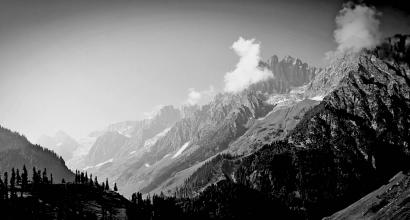Among the enduring myths in which the Dravidianists repose unshakeable faith, the story of the Evil Kalabhras stands foremost. So, who were the Kalabhras? The answer from the pristine-pure Dravidian scholarship says that they were a race who robbed everything that belonged to the Tamils including their very Tamil-ness (Tamil identity), and plunged the Tamil Country into a Dark Age. But when Dr. B G L Swamy asked the “pure Tamils” and the “warrior-Tamils” of his time who these Kalabhras were, the answer was unanimous:
“They were not Tamils. They were extremely wicked and absolute murderers.”
Next question: “So where did they hail from?”
“No idea. But there’s no doubt that they came from outside Tamil Nadu.”
“Any knowledge as to their customs, language, dress, and behavior?”
“It appears that they had Sanskrit and Prakrit as their mother tongue. They destroyed us Tamils.”
“But you say that they had occupied Tamil Nadu for about three hundred or three hundred and fifty years? And so, during such a long spell, have you discovered any remnants they must have left behind?”
“Perhaps. But none of those remains have been spotted.”
“Have they been washed away by the sea?”
“Why not?”
Dr. Swamy notes how the (mythical) invasion and subsequent occupation of Tamil Nadu by the Kalabhras provided a very convenient handle to the Dravidianists. The following is a sample of how this scheme worked: Let’s assume you asked the Dravidianists whether a certain facet of life or quality of nobility or philosophy existed in Tamil literature or culture. Pat comes the stock reply: Of course! The principle, philosophy etc that you mention definitely existed. But those Kalabhras invaded us and annihilated everything including this philosophy etc you mentioned. “Indeed, it was they who destroyed our Last Sangam!”
Dr. Swamy notes how the Dravidianists carefully preserved and perpetuated this myth, writing how
“they used the invasion of the Kalabhras as the sturdy bridge that connected the Sangam Era with the Tevara Era. They have also concocted a stunning terminology for this: ‘Kalabhra Interregnum.’ The pronunciation of this term morphed as ‘kaLappira indargerram,’ ‘kaLappArar inter gennam,’ and variants thereof.”
The Kalabhara myth was pervasive throughout Tamil Nadu from “babies” to the aged and the infirm. Morbid tales of Kalabhra cruelty and atrocities were prescribed in the textbooks for middle and high school students. College students studied the Kalabhra Mythology in greater depth. And as Dr. Swamy writes, the “MPhil and PhD students were completely absolved of the difficulty of searching for academic problems and topics for writing their theses.” It was truly multidisciplinary in nature. From students of literature, economics, history, sociology, psychology, the Kalabhra problem was akin to an infant easily accessible to everyone. “Every student twists and chokes it and according to his strength and ability, delivers a few blows striking it, and painting its utter monstrosity in lurid hues. The student gets his degree without a murmur,” notes Dr. Swamy.
A student named Iravanan enrolled for Dr. Swamy’s course. He took eight years to complete his three-year BSc in the third class. Dr. Swamy adds a disclaimer about this:
Please don’t judge all my students by Iravanan’s example. That’s doing me injustice. There are hundreds of my students who are far more intelligent and learned than me. They have also gone on to earn renown both in society and position. But none of them have earned a place in history like Iravanan.
Iravanan’s ardent desire to study the MSc in Botany was never fulfilled, meaning he didn’t qualify for admission. So he enrolled for an M.A in Tamil and graduated swiftly. For his dissertation topic, he chose, “The Administrative Policy of the Kalabhras” and submitted it for evaluation and presently emerged as “Dr. Iravanan.”
When he came for the convocation, he purposely met Dr. B G L Swamy. Knowing that Dr. Swamy was keenly interested in the subject, he showed him his thesis “beaming with great pride.” Dr. Swamy agreed to read it and asked him to return the next day. Here are a few extracts that Dr Swamy quotes from the said thesis.
Words fail us to describe the kind of atrocities that the Kalabhras inflicted upon the Tamils. It is possible to realize them only through personal experience. When I was studying Botany for my BSc course, I underwent a complete experience of this atrocity at the hands of a Kalabhra descendant.
Dr. Iravanan visited Dr. Swamy the following day and collected his thesis. He sought Dr. Swamy’s opinion,
“How is it Ayya (Sir)?”
“It’s good. So, even you have concluded that there was something called a Kalabhra regime?”
“Where’s the doubt in that fact, Ayya? Hasn’t everyone concluded the same? Won’t I look insane if I claim the opposite?”
“I don’t mean to say that. But if you write that the Kalabhras ruled Tamil Nadu for three hundred years, shouldn’t you also list the names of at least two or three kings belonging to the dynasty?”
“What you say is correct Shaar (Sir), but no evidence supporting it has been found. But why Shaar, don’t you believe that the rule of Kalabhras existed?”
“All I’m saying is that there’s no evidence to support such a claim.”
“But of course! Why would you admit the atrocities committed by your own ancestors? You, and people of your ilk will obviously deny it!” he said suggestively and left the place.
There exists a copperplate grant of the Ninth Century Pandya ruler Parantaka Chediyan or Jatilavarma (Nedunjediyan). It is also well-known as the VeLvikuDi Grant (Epigraphia Indica 1923/4, 17: Pp 291-309). Expounding on this grant, Dr. Swamy writes as follows:
The mention of the Kalabhras come to light for the first time in this grant. Although brilliant scholars and researchers like Fleet, Venkayya, Hoskote Krishna Sastri and Krishnaswami Aiyangar have written about this grant, there appears to be a huge shortcoming. It struck me that the meaning of some of the words used in the grant have not been understood in the context in which they are used. They interpreted the phrase, “kaLappiyaranennum kaliyarashan,” to mean “A wicked king of the Kalabhras.” From this meaning, the interpretation that the Kalabhras were a wicked race flowed quite easily!
I suggested that the word “kali” in this context means “warrior” and further showed the etymology of the word “Kalabhra” as follows: kaLabha > kaLabhabhru > kaLabhru > kaLabhra (in Tamil, it becomes “kaLappira”).
I also pointed out the fact that among the royal dynasties of South India, the Western Gangas sported the kaLabha (baby elephant) as their royal insignia. Sripurusha who hailed from this dynasty was a contemporary of Rajasimha I, the father of Nedunchediyan, who commissioned the veLvikuDi grant. In that period, the southern part of GangavaDi [the region encompassing the Malnad, the plains, Hassan, Mysore, Mandya, Chamarajanagar, Tumkur, Bangalore, and Kolar in Karnataka] and the northern part of the Pandya dominion were neighbouring regions.
Using inscriptional evidence, I showed that Sripurusha led an expedition into the Pandya country and that Rajasimha I repelled it, and that the period of the Ganga occupation of the Pandya country was minimal (perhaps only four or five years). With further historical evidence, I concluded that the Ganga-occupied territory in the northern part of the Pandya country was tiny. I emphasized the fact that there was absolutely no historical evidence to claim that the Kalabhras (Gangas in reality) had occupied the entire Chera, Chola and Pandya countries. Therefore, given this tiny geography and the very short period of occupation, it was impossible for the Gangas to either annihilate or vanquish an already-existing culture and literature.
Thus, in my essay, I concluded that adding unnecessary colour and wings to a really insignificant historical incident and then giving it a weighty title like “The Kalabhra Interregnum” was a figment of imagination.
Dr. Swamy comprehensively demolished the Kalabhra myth by showing that there was really no “dark age” in the history, language, culture, society, and politics of Tamil Nadu, and perchance there was such a dark age, it was definitely not caused by the Kalabhras. Dr. Swamy’s paper is titled, Kalabhra Interregnum—A Retrospect and Prospect.
Two things happened after Dr. Swamy’s paper was published. On the one hand, he received letters which “gave me kisses with flowers.” On the other were letters which “pierced me with sharp spikes.” A valorous Tamil named Arunachalam stood on the speaker’s pedestal and thundered, “I am ready to condemn every single word that Dr. Chaamy [Swamy] has written!” But he never followed up on that condemnation. Other “warrior” Tamil litterateurs and historians from the colleges in neighbouring districts gathered in an assembly and unanimously passed an “order” whose text is given below:
About 120 years ago, a wicked race named the Kalabhras raided our Tamil country and inflicted severe mayhem upon the peaceful Tamils living there. This Dark Age came to an end and peace reigned once more. But now, wicked, alien people like Pi. Ci. La. Chaamy [B G L Swamy] are raising the tidal waves of poison in our Tamil history. Such people are shaking the very roots of our deeply held beliefs. They are denying the facts that existed! Sons of the proud heritage of Tamil Supremacy! Tamil Brothers and Sisters! Wake up! Beware! Arise!
This speech was published in the Tamil daily, Kanal on 12 July 1976.



































